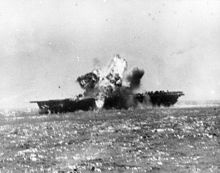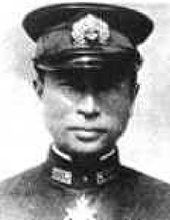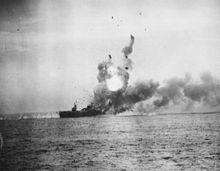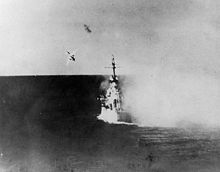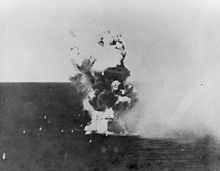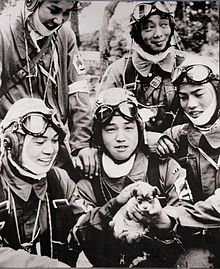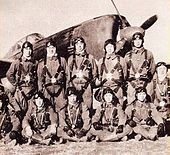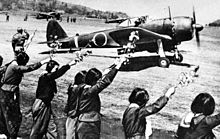- Kamikaze
-
For other uses, see Kamikaze (disambiguation).
 Ensign Kiyoshi Ogawa, who flew his aircraft into the USS Bunker Hill during a Kamikaze mission on 11 May 1945.
Ensign Kiyoshi Ogawa, who flew his aircraft into the USS Bunker Hill during a Kamikaze mission on 11 May 1945.
The Kamikaze (神風, common translation: "Divine wind") [ˌkamiˈkaːzɛ] (
 listen) Tokubetsu Kōgekitai (特別攻撃隊) Tokkō Tai (特攻隊) Tokkō (特攻) were suicide attacks by military aviators from the Empire of Japan against Allied naval vessels in the closing stages of the Pacific campaign of World War II, designed to destroy as many warships as possible.
listen) Tokubetsu Kōgekitai (特別攻撃隊) Tokkō Tai (特攻隊) Tokkō (特攻) were suicide attacks by military aviators from the Empire of Japan against Allied naval vessels in the closing stages of the Pacific campaign of World War II, designed to destroy as many warships as possible.Kamikaze pilots would attempt to crash their aircraft into enemy ships in what was called a "Body Attack" (体当たり; 体当り) taiatari— in planes often laden with explosives, bombs, torpedoes and full fuel tanks. The aircraft's normal functions (to deliver torpedoes or bombs or shoot down other aircraft) were put aside, and the planes were converted to what were essentially manned missiles in an attempt to reap the benefits of greatly increased accuracy and payload over that of normal bombs. The goal of crippling as many Allied ships as possible, particularly aircraft carriers, was considered critical enough to warrant the combined sacrifice of pilots and aircraft.
These attacks, which began in October 1944, followed several critical military defeats for the Japanese. They had long lost aerial dominance due to outdated aircraft and the loss of experienced pilots. On a macroeconomic scale, Japan experienced a decreasing capacity to wage war, and a rapidly declining industrial capacity relative to the United States. The Japanese government expressed its reluctance to surrender. In combination, these factors led to the use of kamikaze tactics as Allied forces advanced towards the Japanese home islands.
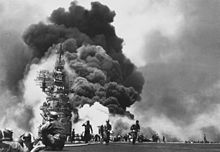 USS Bunker Hill was hit by kamikazes piloted by Ensign Kiyoshi Ogawa (photo above) and another airman on 11 May 1945. 389 personnel were killed or missing from a crew of 2,600.[1]
USS Bunker Hill was hit by kamikazes piloted by Ensign Kiyoshi Ogawa (photo above) and another airman on 11 May 1945. 389 personnel were killed or missing from a crew of 2,600.[1]
While the term "kamikaze" usually refers to the aerial strikes, the term has sometimes been applied to various other intentional suicide attacks. The Japanese military also used or made plans for Japanese Special Attack Units, including those involving submarines, human torpedoes, speedboats and divers. Nazi Germany formed their own group of suicide aircraft pilots called the Leonidas Squadron, but the German commanders demonstrated a greater reluctance to use them.
Although kamikaze was the most common and best-known form of Japanese suicide attack during World War II, they were similar to the "banzai charge" used by Japanese infantrymen (foot soldiers). The main difference between kamikaze and banzai is that death was inherent to the success of a kamikaze attack, whereas a banzai charge was only potentially fatal – that is, the infantrymen hoped to survive but did not expect to. Western sources often incorrectly consider Operation Ten-Go as a kamikaze operation, since it occurred at the Battle of Okinawa along with the mass waves of kamikaze planes; however, banzai is the more accurate term, since the aim of the mission was for battleship Yamato to beach herself and provide support to the island defenders, as opposed to ramming and detonating among enemy naval forces. The tradition of death instead of defeat, capture, and perceived shame was deeply entrenched in Japanese military culture. It was one of the primary traditions in the samurai life and the Bushido code: loyalty and honor until death.
Contents
Definition and etymology
Further information: Battle of Bun'ei and Battle of Kōan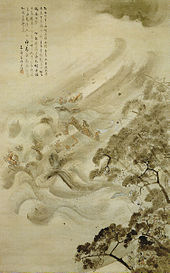 The Mongol fleet destroyed in a typhoon. Ink and water on paper, by Kikuchi Yōsai, 1847
The Mongol fleet destroyed in a typhoon. Ink and water on paper, by Kikuchi Yōsai, 1847
The Japanese word Kamikaze is usually translated as "divine wind" (kami is the word for "god", "spirit", or "divinity", and kaze for "wind"). The word kamikaze originated as the name of major typhoons in 1274 and 1281, which dispersed Mongolian invasion fleets.
In Japanese, the formal term used for units carrying out suicide attacks during 1944–45 is tokubetsu kōgeki tai (特別攻撃隊), which literally means "special attack unit". This is usually abbreviated to tokkōtai (特攻隊). More specifically, air suicide attack units from the Imperial Japanese Navy were officially called shinpū tokubetsu kōgeki tai (神風特別攻撃隊, "divine wind special attack units"). Shinpū is the on-reading (on'yomi or Chinese-derived pronunciation) of the same characters that form the word kamikaze in Japanese. During World War II, the pronunciation kamikaze was used in Japan only informally in relation to suicide attacks, but after the war this usage gained acceptance worldwide and was re-imported into Japan. As a result, the special attack units are sometimes known in Japan as kamikaze tokubetsu kōgeki tai.
Since the end of the war, the term kamikaze has sometimes been used for other kinds of attack in which an attacker is deliberately sacrificed. These include a variety of suicide attacks, in other historical contexts, such as the proposed use of Selbstopfer aircraft by Nazi Germany and various suicide attacks by terrorist organizations around the world (such as the 11 September 2001 attacks), although kamikaze pilots attacked only military buildings/ships, while terrorists attack mostly civilian facilities. In English, the word kamikaze may also be used in a hyperbolic or metaphorical fashion to refer to non-fatal actions which result in significant loss for the attacker, such as injury or the end of a career.
History
Background
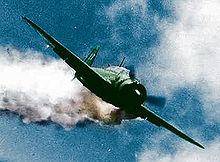 Lt Yoshinori Yamaguchi's Yokosuka D4Y3 (Type 33 Suisei) "Judy" in a suicide dive against USS Essex. The dive brakes are extended and the non-self-sealing port wing tank is trailing fuel vapor and/or smoke 25 November 1944.
Lt Yoshinori Yamaguchi's Yokosuka D4Y3 (Type 33 Suisei) "Judy" in a suicide dive against USS Essex. The dive brakes are extended and the non-self-sealing port wing tank is trailing fuel vapor and/or smoke 25 November 1944.
Prior to the formation of kamikaze units, deliberate crashes had been used as a last resort when a pilot's plane was severely damaged and he did not want to risk being captured, or he wanted to do as much damage to the enemy as possible since he was crashing anyway; this was the case in both the Japanese and Allied air forces. According to Axell & Kase, these suicides "were individual, impromptu decisions by men who were mentally prepared to die."[2] In most cases, there is little evidence that these hits were more than accidental collisions, of the kind that sometimes happen in intense sea-air battles. One example of this occurred on 7 December 1941 during the attack on Pearl Harbor. First Lieutenant Fusata Iida’s plane had been hit and was leaking fuel, when he apparently used it to make a suicide attack on Kaneohe Naval Air Station. Before taking off, he had told his men that if his plane was badly damaged he would crash it into a "worthy enemy target".[3]
The carrier battles in 1942, particularly Midway, had inflicted irreparable damage on the Imperial Japanese Navy Air Service (IJNAS), such that they could no longer put together a large number of fleet carriers with well-trained aircrews.[4] Japanese planners had assumed a quick war and were ill-prepared to replace the losses of ships, pilots, and sailors; at Midway, the Japanese lost as many aircrewmen in a single day as their pre-war training program had produced in a year.[5] The following Solomons and New Guinea campaigns, notably the Battles of Eastern Solomons and Santa Cruz, further decimated their veteran aircrews and replacing their combat experience proved impossible.[6] During 1943–44, U.S. forces were steadily advancing towards Japan. Japan's fighter planes were becoming outnumbered and outclassed by newer U.S.-made planes, especially the F6F Hellcat and F4U Corsair. Tropical diseases, as well as shortages of spare parts and fuel, made operations more and more difficult for the IJNAS. By the Battle of the Philippine Sea in 1944, the Japanese now had to make do with obsolete aircraft and inexperienced aviators, against the better-trained and more experienced US Navy airmen, and its radar-directed combat air patrols. The Japanese lost over 400 carrier-based planes and pilots, effectively putting an end to their carriers' potency, an action referred to by the Allies as the "Great Marianas Turkey Shoot".
On 19 June 1944, planes from the carrier Chiyoda approached a US task group. According to some accounts, two made suicide attacks, one of which hit USS Indiana.[7]
The important Japanese base of Saipan fell to the Allied forces on 15 July 1944. Its capture provided adequate forward bases which enabled U.S. air forces using the B-29 Superfortress to strike the Japanese home islands. After the fall of Saipan, the Japanese high command predicted that the Allies would try to capture the Philippines, which were strategically important because of their location between the oilfields of Southeast Asia and Japan.
In August 1944, it was announced by the Domei news agency that a flight instructor named Takeo Tagata was training pilots in Taiwan for suicide missions.[8]
Another source claims that the first kamikaze mission occurred on 13 September 1944. A group of pilots from the army's 31st Fighter Squadron on Negros Island decided to launch a suicide attack the following morning.[9] First Lieutenant Takeshi Kosai and a sergeant were selected. Two 100 kg (220 lb) bombs were attached to two fighters, and the pilots took off before dawn, planning to crash into carriers. They never returned, and there is no record of an enemy plane hitting an Allied ship that day.
According to some sources, on 14 October 1944, USS Reno was hit by a deliberately-crashed Japanese plane.[10] However, there is no evidence that the attacker planned to crash.[citation needed]
Rear Admiral Masafumi Arima, the commander of the 26th Air Flotilla (part of the 11th Air Fleet), is also sometimes credited with inventing the kamikaze tactic. Arima personally led an attack by about 100 Yokosuka D4Y Suisei ("Judy") dive bombers against a large Essex-class aircraft carrier, USS Franklin near Leyte Gulf, on (or about, accounts vary) 15 October 1944. Arima was killed and part of a plane hit Franklin. The Japanese high command and propagandists seized on Arima's example: he was promoted posthumously to Admiral and was given official credit for making the first kamikaze attack. However, it is not clear that this was a planned suicide attack,[11] and official Japanese accounts of Arima's attack bore little resemblance to the actual events.
On 17 October 1944, Allied forces assaulted Suluan Island, beginning the Battle of Leyte Gulf. The Imperial Japanese Navy's 1st Air Fleet, based at Manila, was assigned the task of assisting the Japanese ships which would attempt to destroy Allied forces in Leyte Gulf. However, the 1st Air Fleet at that time only had 40 aircraft: 34 A6M Zero carrier-based fighters, three Nakajima B6N Tenzan ("Jill") torpedo bombers, one Mitsubishi G4M ("Betty") and two Yokosuka P1Y Ginga ("Frances") land-based bombers, and one additional reconnaissance plane. The task facing the Japanese air forces seemed impossible. The 1st Air Fleet commandant, Vice Admiral Takijirō Ōnishi decided to form a suicide attack force, the Special Attack Unit. In a meeting at Mabalacat Airfield (known to the U.S. military as Clark Air Base) near Manila, on 19 October, Onishi told officers of the 201st Flying Group headquarters: "I don't think there would be any other certain way to carry out the operation [to hold the Philippines], than to put a 250 kg bomb on a Zero and let it crash into a U.S. carrier, in order to disable her for a week."
First kamikaze unit
Commander Asaiki Tamai asked a group of 23 talented student pilots, all of whom he had trained, to volunteer for the special attack force. All of the pilots raised both of their hands, volunteering to join the operation. Later, Tamai asked Lieutenant Yukio Seki to command the special attack force. Seki is said to have closed his eyes, lowered his head and thought for 10 seconds, before saying: "Please do appoint me to the post." Seki became the 24th kamikaze pilot to be chosen. However, Seki later said: "Japan's future is bleak if it is forced to kill one of its best pilots." and "I am not going on this mission for the Emperor or for the Empire... I am going because I was ordered to."[12]
The names of four sub-units within the Kamikaze Special Attack Force were Unit Shikishima, Unit Yamato, Unit Asahi, and Unit Yamazakura.[13] These names were taken from a patriotic death poem (called jisei no ku in waka or tanka), Shikishima no Yamato-gokoro wo hito towaba, asahi ni niou yamazakura bana by the Japanese classical scholar, Motoori Norinaga.[14] The poem reads:
If someone asks about the Yamato spirit [Spirit of Old/True Japan] of Shikishima [a poetic name for Japan]—it is the flowers of yamazakura [mountain cherry blossom] that are fragrant in the Asahi [rising sun].A less literal translation[15] is:
- Asked about the soul of Japan,
- I would say
- That it is
- Like wild cherry blossoms
- Glowing in the morning sun.
Ōnishi, addressing this unit, told that their nobility of spirit would keep the homeland from ruin even in defeat.[16]
Leyte Gulf: the first attacks
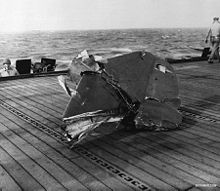 Starboard horizontal stabilizer from the tail of a "Judy" on the deck of USS Kitkun Bay. The "Judy" made a run on the ship approaching from dead astern, it was met by effective fire and the plane passed over the island and exploded. Parts of the plane and the pilot were scattered over the flight deck and the forecastle.
Starboard horizontal stabilizer from the tail of a "Judy" on the deck of USS Kitkun Bay. The "Judy" made a run on the ship approaching from dead astern, it was met by effective fire and the plane passed over the island and exploded. Parts of the plane and the pilot were scattered over the flight deck and the forecastle.
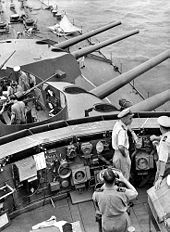 The bridge and forward turrets of the County-class heavy cruiser HMAS Australia, in September 1944. The officer facing right is Captain Emile Dechaineux who was killed on 21 October 1944 in what is reported as the first kamikaze attack.
The bridge and forward turrets of the County-class heavy cruiser HMAS Australia, in September 1944. The officer facing right is Captain Emile Dechaineux who was killed on 21 October 1944 in what is reported as the first kamikaze attack.
Several suicide attacks, carried out during the invasion of Leyte, by Japanese pilots from units other than the Special Attack Force, have been described as the first kamikaze attack. Early on 21 October, a Japanese aircraft, possibly a Aichi D3A dive-bomber[17] or a Mitsubishi Ki-51 (of the 6th Flying Brigade, Imperial Japanese Army Air Force[18]) deliberately crashed into the foremast of the heavy cruiser HMAS Australia.[17] The attack killed 30 personnel, including the cruiser's Captain, Emile Dechaineux and wounded 64, including the Australian force commander Commodore John Collins.[17] The Australian official history of the war claimed that this was the first kamikaze attack on an Allied ship, although other sources disagree because it was not a planned attack by a member of the Special Attack Force, but was most likely performed on the pilot's own initiative.[17]
The sinking of the ocean tug USS Sonoma on 24 October is listed in some sources as the first ship lost to a kamikaze strike, but the attack occurred before 25 October, and the aircraft used, a Mitsubishi G4M, was not flown by the original four Special Attack Squadrons.[19]
On 25 October 1944, during the Battle of Leyte Gulf, the Kamikaze Special Attack Force carried out its first mission. Five Zeros, led by Seki, and escorted to the target by leading Japanese ace Hiroyoshi Nishizawa, attacked several escort carriers. One Zero attempted to hit the bridge of USS Kitkun Bay but instead exploded on the port catwalk and cartwheeled into the sea. Two others dove at USS Fanshaw Bay but were destroyed by anti-aircraft fire. The last two ran at USS White Plains. One, under heavy fire and trailing smoke, aborted the attempt on White Plains and instead banked toward USS St. Lo, plowing into the flight deck. Its bomb caused fires that resulted in the bomb magazine exploding, sinking the carrier.[20] By day's end on 26 October, 55 kamikazes from the special attack force had also damaged the large escort carriers USS Sangamon, Suwannee which had also been struck by a Kamikaze at 0804 forward of its aft elevator on 25 October, Santee, and the smaller escorts USS White Plains, Kalinin Bay, and Kitkun Bay. In total, seven carriers had been hit, as well as 40 other ships (five sunk, 23 heavily damaged, and 12 moderately damaged).
Main wave of attacks
Early successes – such as the sinking of St. Lo – were followed by an immediate expansion of the program, and over the next few months over 2,000 planes made such attacks.
When Japan began to be subject to intense strategic bombing by B-29s, the Japanese military attempted to use suicide attacks against this threat. During the northern hemisphere winter of 1944–45, the IJAAF formed the 47th Air Regiment, also known as the Shinten Special Unit (Shinten Seiku Ta) at Narimasu Airfield, Nerima, Tokyo, to defend the Tokyo Metropolitan Area. The unit was equipped with Nakajima Ki-44 Shoki ("Tojo") fighters, with which they were to ram United States Army Air Forces (USAAF) B-29s in their attacks on Japan. However, this proved much less successful and practical since an airplane is a much faster, more maneuverable, and smaller target than a warship. The B-29 also had formidable defensive weaponry, so suicide attacks against the plane demanded considerable piloting skill to be successful. That worked against the very purpose of using expendable pilots and even encouraging capable pilots to bail out before impact was ineffective because vital personnel were often lost when they mistimed their exits and were killed as a result.
Kamikaze attacks were being planned at far-flung Japanese bases. On 8 January, Onishi formed a second official naval kamikaze unit, in Formosa.[citation needed] The unit, Niitaka used Zeroes and "Judys", and was based at Takao Airfield. On 29 January 1945, seven Kawasaki Ki-48 "Lilys" from the Japanese Army Shichisi Mitate Special group, took off from Palembang, Sumatra to strike the British Pacific Fleet. Vice Admiral Kimpei Teraoka and Captain Riishi Sugiyama of the 601st Air Group organized another second special unit, Mitate at Iwo Jima on 16 February, as a U.S. invasion force approached.[citation needed] On 11 March, the U.S. carrier USS Randolph was hit and moderately damaged at Ulithi Atoll, in the Caroline Islands, by a kamikaze that had flown almost 4,000 km (2,500 mi) from Japan, in a mission called Operation Tan No. 2. On 20 March, the submarine USS Devilfish survived a hit from an aircraft, just off Japan.
Purpose-built kamikaze planes, as opposed to converted fighters and dive-bombers, were also being constructed. Ensign Mitsuo Ohta had suggested that piloted glider bombs, carried within range of targets by a mother plane, should be developed. The First Naval Air Technical Bureau (Kugisho), in Yokosuka, refined Ohta's idea. Yokosuka MXY7 Ohka rocket planes, launched from bombers, were first deployed in kamikaze attacks from March 1945. U.S. personnel gave them the derisive nickname "Baka Bombs" (baka is Japanese for "idiot" or "stupid"). A specially-designed propeller plane, the Nakajima Ki-115 Tsurugi, was a simple, easily-built aircraft, intended to use up existing stocks of engines, in a wooden airframe. The landing gear was non-retractable: it was jettisoned shortly after take-off for a suicide mission and then re-used on other planes. During 1945, the Japanese military began stockpiling hundreds of Tsurugi, other propeller planes, Ohkas, and suicide boats, for use against Allied forces expected to invade Japan. Few were ever used.[21]
Allied defensive tactics
In early 1945, Commander John Thach, a U.S. Navy aviator, who was already famous for developing effective aerial tactics against the Japanese such as the Thach Weave, developed a defensive strategy against kamikazes called the "big blue blanket". This recommended larger combat air patrols (CAP), further from the carriers than had previously been the case, a line of picket destroyers and destroyer escorts at least 80 km (50 mi) from the main body of the fleet to provide earlier radar interception, and improved coordination between fighter direction officers on carriers. This plan also called for round-the-clock fighter patrols over Allied fleets, though the U.S. Navy had cut back training of fighter pilots, so there were not enough Navy pilots available to counter the kamikaze threat. A final element included intensive fighter sweeps over Japanese airfields, and bombing of Japanese runways with delayed action fuses to make repairs more difficult.[22]
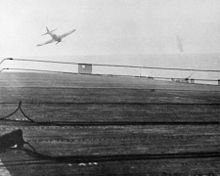 An A6M Zero (A6M2 Model 21) towards the end of its run at the escort carrier USS White Plains on 25 October 1944. The aircraft exploded in mid-air, moments after the picture was taken, scattering debris across the deck.
An A6M Zero (A6M2 Model 21) towards the end of its run at the escort carrier USS White Plains on 25 October 1944. The aircraft exploded in mid-air, moments after the picture was taken, scattering debris across the deck.
Late in 1944, the British Pacific Fleet (BPF) used the good high altitude performance of their Supermarine Seafires on combat air patrol duties. Seafires were heavily involved in countering the kamikaze attacks during the Iwo Jima landings and beyond. The Seafires' best day was 15 August 1945, shooting down eight attacking aircraft for a single loss.
Poor training tended to make kamikaze pilots easy targets for experienced Allied pilots, who also flew superior aircraft. The U.S. Fast Carrier Task Force alone could bring over 1,000 fighter aircraft into play. Allied pilots became adept at destroying enemy aircraft before they struck ships.
Allied gunners had begun to develop techniques to negate kamikaze attacks. Light rapid fire anti-aircraft weapons such as the 40 mm Bofors and Oerlikon 20 mm cannons were still highly effective,[23] however heavy anti-aircraft guns such as the 5"/38 caliber gun (127 mm) had the punch to blow kamikazes out of the air, which was often necessary since even a heavily damaged kamikaze could complete its mission.[24] The Ohkas with their high speed presented a very difficult problem for anti-aircraft fire, since their high speed made a fire control solution extremely difficult. By 1945, large amounts of anti-aircraft shells with radio frequency proximity fuzes became available, these were on average seven times more effective than regular shells, and the USN recommended their use against kamikaze attacks.
Final phase
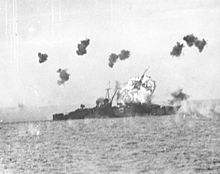 The USS Louisville is struck by a kamikaze at the Battle of Lingayen Gulf, January 1945.
The USS Louisville is struck by a kamikaze at the Battle of Lingayen Gulf, January 1945.
The peak in kamikaze attacks came during the period of April–June 1945, at the Battle of Okinawa. On 6 April 1945, waves of planes made hundreds of attacks in Operation Kikusui ("floating chrysanthemums").[25] At Okinawa, kamikaze attacks focused at first on Allied destroyers on picket duty, and then on the carriers in the middle of the fleet. Suicide attacks by planes or boats at Okinawa sank or put out of action at least 30 U.S. warships,[26] and at least three U.S. merchant ships,[27] along with some from other Allied forces. The attacks expended 1,465 planes. Many warships of all classes were damaged, some severely, but no aircraft carriers, battleships or cruisers were sunk by kamikaze at Okinawa. Most of the ships lost were destroyers or smaller vessels, especially those on picket duty.[26] The destroyer USS Laffey earned the nickname "The Ship That Would Not Die" after surviving sixteen kamikaze attacks, including five hits during this battle.[28]
 The Royal Navy carrier HMS Victorious after three successive kamikaze hits, her armoured deck meant that damage was superficial and she was launching planes within one hour of the attack.
The Royal Navy carrier HMS Victorious after three successive kamikaze hits, her armoured deck meant that damage was superficial and she was launching planes within one hour of the attack.
U.S. carriers, with their wooden flight decks, appeared to suffer more damage from kamikaze hits than the reinforced steel-decked carriers from the British Pacific Fleet. US carriers also suffered considerably heavier casualties from kamikaze strikes, for instance 389 men were killed in one attack on USS Bunker Hill and this is greater than the combined number of fatal casualties suffered on all six RN armoured carriers from all forms of attack for the entire war; eight kamikaze hits on five RN carriers resulted in only twenty fatal casualties while a combined total of 15 bomb hits, most of 500 kg weight or greater, and one torpedo hit on 4 carriers caused 193 fatal casualties earlier in the war – striking proof of the protective value of the armoured flight deck.[29][30] The resilience of well-armoured vessels was shown on 4 May, just after 11:30, when there was a wave of suicide attacks against the BPF. One Japanese plane made a steep dive from "a great height" at the carrier HMS Formidable and was engaged by AA guns.[31] Although it was hit by gunfire, the kamikaze crashed into the flight deck, making a crater 3 m (9.8 ft) long, 0.6 m (2 ft) wide and 0.6 m (2 ft) deep. A long steel splinter speared down, through the hangar deck and the main boiler room (where it ruptured a steam line), before coming to rest in a fuel tank near the aircraft park, where it started a major fire. Eight personnel were killed and 47 were wounded. One Corsair and 10 Avengers were destroyed. However, the fires were gradually brought under control, and the crater in the deck was repaired with concrete and steel plate. By 17:00, Corsairs were able to land. On 9 May, Formidable was again damaged by a kamikaze, as were the carrier HMS Victorious and the battleship HMS Howe. The British were able to clear the flight deck and resume flight operations in just hours, while their American counterparts took a few days or even months, as observed by a USN liaison officer on HMS Indefatigable who commented: "When a kamikaze hits a U.S. carrier it means 6 months of repair at Pearl [Harbor]. When a kamikaze hits a Limey carrier it’s just a case of "Sweepers, man your brooms."”
Sometimes twin-engined aircraft were used in planned kamikaze attacks. For example, Mitsubishi Ki-67 Hiryū ("Peggy") medium bombers, based on Formosa, undertook kamikaze attacks on Allied forces off Okinawa.
Rear Admiral Matome Ugaki, the second in command of the Combined Pacific Fleet, directed the last official kamikaze attack, sending "Judies" from the 701st Air Group against the Allied fleet at Okinawa on 15 August 1945.
Effects
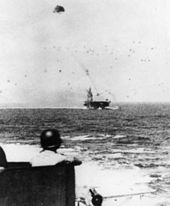 A crewman in an AA gun aboard the battleship New Jersey watches a kamikaze plane descend upon Intrepid 25 November 1944
A crewman in an AA gun aboard the battleship New Jersey watches a kamikaze plane descend upon Intrepid 25 November 1944
As the end of the war approached, the Allies did not suffer significantly more serious losses, despite having far more ships and facing a greater intensity of kamikaze attacks. Although causing some of the heaviest casualties on US carriers in 1945, the IJN had sacrificed 2,525 kamikaze pilots and the IJAAF 1,387; far more than they had lost in 1942 where they sunk or crippled three carriers (albeit without inflicting significant casualties). In 1942 when US Navy vessels were scarce, the temporary absence of key warships from the combat zone would tie up operational initiatives. However, by 1945, the US Navy was large enough that damaged ships could be detached back home for repair without significantly hampering the fleet's operational capability. The only surface losses were destroyers and smaller ships that lacked the capability to sustain heavy damage. Overall, the kamikazes were unable to turn the tide of the war and stop the Allied invasion. The destructive potential of the kamikaze sustained postwar funding of Operation Bumblebee until the RIM-8 Talos guided missile became operational in 1959.[32]
In the immediate aftermath of kamikaze strikes, British carriers with their armoured flight decks appeared to recover more quickly compared to their US counterparts. However, post-war analysis showed that some British carriers such as HMS Formidable did suffer structural damage that led them to be written off and scrapped, as beyond economic repair, but Britain's dire post war finances and the constantly declining size of the Royal Navy undoubtedly played a role in deciding not to repair damaged carriers. By contrast, even the most seriously damaged American carriers such USS Bunker Hill were successfully repaired to operational condition, although they saw no service after World War II as they were considered surplus.
The number of ships sunk is a matter of debate. According to a wartime Japanese propaganda announcement, the missions sank 81 ships and damaged 195, and according to a Japanese tally, kamikaze attacks accounted for up to 80% of the U.S. losses in the final phase of the war in the Pacific. In a 2004 book, World War II, the historians Wilmott, Cross and Messenger stated that more than 70 U.S. vessels were "sunk or damaged beyond repair" by kamikazes.
According to a U.S Air Force webpage:
- Approximately 2,800 Kamikaze attackers sunk 34 Navy ships, damaged 368 others, killed 4,900 sailors, and wounded over 4,800. Despite radar detection and cuing, airborne interception and attrition, and massive anti-aircraft barrages, a distressing 14 percent of Kamikazes survived to score a hit on a ship; nearly 8.5 percent of all ships hit by Kamikazes sank.[33]
Australian journalists Denis and Peggy Warner, in a 1982 book with Japanese naval historian Seno Sadao (The Sacred Warriors: Japan’s Suicide Legions), arrived at a total of 57 ships sunk by kamikazes. However, Bill Gordon, an American Japanologist who specialises in kamikazes, states in a 2007 article that 47 ships were sunk by kamikaze aircraft.[19] Gordon says that the Warners and Seno included ten ships that did not sink. His list consists of:
- three escort carriers: USS St. Lo, USS Ommaney Bay, and USS Bismarck Sea
- 14 destroyers, including the last ship to be sunk, USS Callaghan (DD-792) on 29 July 1945, off Okinawa
- three high-speed transport ships
- five Landing Ship, Tank
- four Landing Ship Medium
- three Landing Ship Medium (Rocket)
- one auxiliary tanker
- three Canadian Victory ships
- three Liberty ships
- two high-speed minesweepers
- one Auk class minesweeper
- one submarine chaser
- two PT boats
- two Landing Craft Support
Over 300 Allied warships were damaged by kamikaze attacks.[citation needed]
Recruitment
 Japanese Yokosuka MXY-7 Ohka ("cherry blossom"), a specially built rocket-powered kamikaze aircraft used towards the end of the war. The U.S. called them Baka ("idiot").
Japanese Yokosuka MXY-7 Ohka ("cherry blossom"), a specially built rocket-powered kamikaze aircraft used towards the end of the war. The U.S. called them Baka ("idiot").
It was claimed by the Japanese forces at the time that there were many volunteers for the suicidal forces. Captain Motoharu Okamura commented that "there were so many volunteers for suicide missions that he referred to them as a swarm of bees," explaining: "Bees die after they have stung."[34] Okamura is credited with being the first to propose the kamikaze attacks. He had expressed his desire to lead a volunteer group of suicide attacks some four months before Admiral Takijiro Ohnishi, commander of the Japanese naval air forces in the Philippines, presented the idea to his staff. While Vice Admiral Shigeru Fukudome, commander of the second air fleet, was inspecting the 341st Air Group, Captain Okamura took the chance to express his ideas on crash-dive tactics. “In our present situation I firmly believe that the only way to swing the war in our favor is to resort to crash-dive attacks with our planes. There is no other way. There will be more than enough volunteers for this chance to save our country, and I would like to command such an operation. Provide me with 300 planes and I will turn the tide of war.”[35] When the volunteers arrived for duty in the corps there were twice as many persons as aircraft. "After the war, some commanders would express regret for allowing superfluous crews to accompany sorties, sometimes squeezing themselves aboard bombers and fighters so as to encourage the suicide pilots and, it seems, join in the exultation of sinking a large enemy vessel." Many of the kamikaze pilots believed their death would pay the debt they owed and show the love they had for their families, friends, and emperor. "So eager were many minimally trained pilots to take part in suicide missions that when their sorties were delayed or aborted, the pilots became deeply despondent. Many of those who were selected for a bodycrashing mission were described as being extraordinarily blissful immediately before their final sortie."[36]
As time wore on, however, modern critics questioning the nationalist portrayal of kamikaze pilots as noble soldiers willing to sacrifice their lives for the country have emerged. In 2006, Tsuneo Watanabe, Editor-in-Chief of the Yomiuri Shimbun, criticized Japanese nationalists' glorification of kamikaze attacks:[37][38]
http://articles.latimes.com/2004/sep/25/world/fg-kamikaze25
"It's all a lie that they left filled with braveness and joy, crying, 'Long live the emperor!' They were sheep at a slaughterhouse. Everybody was looking down and tottering. Some were unable to stand up and were carried and pushed into the plane by maintenance soldiers."
Training
When you eliminate all thoughts about life and death, you will be able to totally disregard your earthly life. This will also enable you to concentrate your attention on eradicating the enemy with unwavering determination, meanwhile reinforcing your excellence in flight skills.—An excerpt from a kamikaze pilots' manual.Tokkōtai pilot training, as described by Kasuga Takeo,[39] generally "consisted of incredibly strenuous training, coupled with cruel and torturous corporal punishment as a daily routine." Irokawa Daikichi, who trained at Tsuchiura Naval Air Base, recalled that he "was struck on the face so hard and frequently that [his] face was no longer recognizable." He also wrote: "I was hit so hard that I could no longer see and fell on the floor. The minute I got up, I was hit again by a club so that I would confess." This brutal "training" was justified by the idea that it would instill a "soldier's fighting spirit." However, daily beatings and corporal punishment eliminated patriotism among many pilots.[40]
Pilots were given a manual which detailed how they were supposed to think, prepare, and attack. From this manual, pilots were told to "attain a high level of spiritual training," and to "keep [their] health in the very best condition." These things, among others, were meant to put the pilot into the mindset in which he would be mentally ready to die.
The tokkōtai pilot's manual also explained how a pilot may turn back if the pilot could not locate a target and that "[a pilot] should not waste [his] life lightly." However, one pilot who continually came back to base was shot after his ninth return.[40]
We tried to live with 120 percent intensity, rather than waiting for death. We read and read, trying to understand why we had to die in our early twenties. We felt the clock ticking away towards our death, every sound of the clock shortening our lives.
Irokawa Daikichi, Kamikaze Diaries: Reflections of Japanese Student SoldiersThe manual was very detailed in how a pilot should attack. A pilot would dive towards his target and "aim for a point between the bridge tower and the smoke stacks". Entering a smoke stack was also said to be "effective". Pilots were told not to aim at a ship's bridge tower or gun turret but instead to look for elevators or the flight deck to crash into. For horizontal attacks, the pilot was to "aim at the middle of the vessel, slightly higher than the waterline" or to "aim at the entrance to the aircraft hangar, or the bottom of the stack" if the former was too difficult.
The tokkōtai pilot's manual told pilots never to close their eyes. This was because if a pilot closed his eyes he would lower the chances of hitting his target. In the final moments before the crash, the pilot was to yell "Hissatsu" (必殺) at the top of his lungs which translates to "Certain Kill".
Cultural background
In 1944–45, the Japanese were heavily influenced by Shinto beliefs. Among other things, Emperor worship was stressed after Shinto was established as a state religion during the Meiji Restoration. As time went on, Shinto was used increasingly in the promotion of nationalist sentiment. In 1890, the Imperial Rescript on Education was passed, under which students were required to ritually recite its oath to offer themselves "courageously to the State" as well as protect the Imperial family. The ultimate offering was to give up one’s life. It was an honor to die for Japan and the Emperor. Axell and Kase pointed out: "The fact is that innumerable soldiers, sailors and pilots were determined to die, to become eirei, that is ‘guardian spirits’ of the country. [...] Many Japanese felt that to be enshrined at Yasukuni was a special honour because the Emperor twice a year visited the shrine to pay homage. Yasukuni is the only shrine, deifying common men, which the Emperor would visit to pay his respects".[34] Young Japanese people were indoctrinated from an earliest age with these ideals.
Following the commencement of the kamikaze tactic, newspapers and books ran advertisements, articles, and stories regarding the suicide bombers, to aid in recruiting and support. In October 1944, the Nippon Times quoted Lieutenant Sekio Nishina: "The spirit of the Special Attack Corps is the great spirit that runs in the blood of every Japanese…. The crashing action which simultaneously kills the enemy and oneself without fail is called the Special Attack…. Every Japanese is capable of becoming a member of the Special Attack Corps".[41] Publishers also played up the idea that the kamikaze were enshrined at Yasukuni and ran exaggerated stories of kamikaze bravery – there were even fairy tales for little children that promoted the kamikaze. A Foreign Office official named Toshikazu Kase said: "It was customary for GHQ [in Tokyo] to make false announcements of victory in utter disregard of facts, and for the elated and complacent public to believe them".[42]
While many stories were falsified, some were true, such as the story of Kiyu Ishikawa who saved a Japanese ship when he crashed his plane into a torpedo that an American submarine had launched. The sergeant major was posthumously promoted to second lieutenant by the emperor and was enshrined at Yasukuni.[43] Stories like these, which showed the kind of praise and honor death produced, encouraged young Japanese to volunteer for the Special Attack Corps and instilled a desire in the youth to die as a kamikaze.
Ceremonies were carried out before kamikaze pilots departed on their final mission. They were given the flag of Japan or the rising sun flag (Japanese naval ensign), inscribed with inspirational and spiritual words, Nambu pistol or katana and drank sake before they took off generally. They put on a hachimaki headband with the rising sun, and a senninbari, a "belt of a thousand stitches" sewn by a thousand women who made one stitch each.[44] They also composed and read a death poem, a tradition stemming from the samurai, who did it before committing seppuku. Pilots carried prayers from their families and were given military decorations.
While commonly perceived that volunteers signed up in droves for kamikaze missions, it has also been contended that there was extensive coercion and peer pressure involved in recruiting soldiers for the sacrifice. Their motivations in "volunteering" were complex and not simply about patriotism or bringing honour to their families. And at least one of these pilots was a conscripted Korean with a Japanese name, adopted under the pre-war Soshi-kaimei ordinance that compelled Koreans to take Japanese personal names.[45] Out of the 1,036 IJA kamikaze pilots who died in sorties from Chiran and other Japanese air bases, during the Battle of Okinawa, 11 were Koreans.[46][47]
According to legend, young pilots on kamikaze missions often flew southwest from Japan over the 922 m (3,025 ft) Mount Kaimon. The mountain is also called "Satsuma Fuji" (meaning a mountain like Mount Fuji but located in the Satsuma Province region). Suicide mission pilots looked over their shoulders to see this, the most southern mountain on the Japanese mainland, while they were in the air, said farewell to their country, and saluted the mountain.
Residents on Kikaishima Island, east of Amami Ōshima, say that pilots from suicide mission units dropped flowers from the air as they departed on their final missions. According to legend, the hills above Kikaishima airport have beds of cornflower that bloom in early May.[48]
Kamikaze pilots that were unable to complete their mission (due to mechanical failure, interception, etc.) were stigmatized in the years following the war. This stigma began to diminish some 50 years after the war as scholars and publishers have distributed the survivor's stories.[49]
With the passing of time, some prominent Japanese military figures who survived the war became critical of the policy. Saburo Sakai, an IJN ace said:
"A kamikaze is a surprise attack, according to our ancient war tactics. Surprise attacks will be successful the first time, maybe two or three times. But what fool would continue the same attacks for ten months? Emperor Hirohito must have realized it. He should have said 'Stop.'
"Even now, many faces of my students come up when I close my eyes. So many students are gone. Why did headquarters continue such silly attacks for ten months! Fools! Genda, who went to America—all those men lied that all men volunteered for kamikaze units. They lied."Quotations
I cannot predict the outcome of the air battles, but you will be making a mistake if you should regard Special Attack operations as normal methods. The right way is to attack the enemy with skill and return to the base with good results. A plane should be utilized over and over again. That’s the way to fight a war. The current thinking is skewed. Otherwise, you cannot expect to improve air power. There will be no progress if flyers continue to die.
—Lieutenant Commander Iwatani, Taiyo (Ocean) magazine, March 1945.[43]
Zwei Seelen wohnen auch in mein[em] Herz!! (Ah, two souls [tamashi’i] reside in my heart [kokoro]!!) After all I am just a human being. Sometimes, my chest pounds with excitement when I think of the day I will fly into the sky. I trained my mind and body as hard as I could and am anxious for the day I can use them to their full capacity in fighting. I think my life and death belong to the mission. Yet, at other times, I envy those science majors who remain at home [exempt from the draft]. … One of my souls looks to heaven, while the other is attracted to the earth. I wish to enter the Navy as soon as possible so that I can devote myself to the task. I hope that the days when I am tormented by stupid thoughts will pass quickly.
—Sasaki Hachiro[50]
It is easy to talk about death in the abstract, as the ancient philosophers discussed. But it is real death I fear, and I don’t know if I can overcome the fear. Even for a short life, there are many memories. For someone who had a good life, it is very difficult to part with it. But I reached a point of no return. I must plunge into an enemy vessel.
To be honest, I cannot say that the wish to die for the emperor is genuine, coming from my heart. However, it is decided for me that I die for the emperor.—Hayashi Ichizo[51]
I am pleased to have the honour of having been chosen as a member of a Special Attack Force that is on its way into battle, but I cannot help crying when I think of you, Mum. When I reflect on the hopes you had for my future ... I feel so sad that I am going to die without doing anything to bring you joy.
—Ichizo Hayashi, last letter home a few days before his final flight. April 1945[52]
Film
- Saigo no Tokkotai aka The Last Kamikaze (1970) – Directed by Yahagi Toshihiko and Starring Koji Tsuruta, Ken Takakura and Shinichi Chiba
- Masami Takahashi, Last Kamikaze Testimonials from WWII Suicide Pilots (Watertown, MA: Documentary Educational Resources, 2008).
- Risa Morimoto, Wings of Defeat (Harriman, NY: New Day Films, 2007).
See also
- Banzai charge
- Bushidō
- Giretsu
- Living torpedoes
- Ramming
- Suicide weapon
- "Umi Yukaba"
- Vehicle explosion
- Rammkommando "ELBE"
- Shiggy Konno
- Chiran Special Attack Peace Museum
- Leonidas Squadron - Nazi suicide pilot unit
References
Notes
- ^ Bunker Hill I, Dictionary of American Naval Fighting Ships, Naval Historical Center, 22 November 2005.
- ^ Axell, pp. 34, 40–41
- ^ Axell, p.44 —A monument at the site of Iida’s crash reads: 'JAPANESE AIRCRAFT IMPACT SITE. PILOT-LIEUTENANT IIDA, COMMANDER, THIRD AIR CONTROL GROUP, DEC. 7, 1941.’”
- ^ U.S. Naval War College Analysis, p.1; Parshall and Tully, Shattered Sword, pp.416–430.
- ^ Peattie, Sunburst, pp.131–134, 181–184, & 191–192..
- ^ Peattie, Sunburst, pp.176–186; Eric Bergerud, Fire in the Sky, p.668.
- ^ Fighting Elites: Kamikaze: 9, 12
- ^ Axell, pp.40–41
- ^ Toland, p.568
- ^ ww2pacific.com, 2004, "World War II in the Pacific: Japanese Suicide Attacks at Sea". Access date: 1 August 2007.
- ^ Bill Gordon, 2005, "(Review of) No Surrender: German and Japanese Kamikazes" Access date: 1 August 2007
- ^ Axell, p.16
- ^ Ivan Morris, The Nobility of Failure: Tragic Heroes in the History of Japan, p289 Holt, Rinehart and Winston, 1975
- ^ Ivan Morris, The Nobility of Failure: Tragic Heroes in the History of Japan, p289–90 Holt, Rinehart and Winston, 1975
- ^ "Motoori Norinaga: A scholar-physician who loved cherry blossoms", THE EAST, Vol. XXVI No, 1
- ^ Ivan Morris, The Nobility of Failure: Tragic Heroes in the History of Japan, p284 Holt, Rinehart and Winston, 1975
- ^ a b c d Nichols, Robert (2004). "The first kamikaze attack?". Wartime (Australian War Memorial) (28). http://www.awm.gov.au/wartime/28/article.asp. Retrieved 15 August 2010.
- ^ Richard L. Dunn, 2002–2005, "First Kamikaze? Attack on HMAS Australia—21 October 1944" (j-aircraft.com). Access date: 20 June 2007. If the pilot was from the 6th Flying Brigade, it was probably either Lieutenant Morita or Sergeant Itano, flying out of San Jose, Mindoro.
- ^ a b Gordon, Bill. "47 Ships Sunk by Kamikaze Aircraft". Kamikaze Image s. http://wgordon.web.wesleyan.edu/kamikaze/background/ships-sunk/index.htm. Retrieved 15 August 2010.
- ^ Toland, p.567
- ^ Japanese Ki-9 biplane
- ^ Bill Coombes, 1995, "Divine Wind The Japanese secret weapon – kamikaze suicide attacks"
- ^ USN, Antiaircraft Action Summary Suicide Attacks, April 1945
- ^ DiGiulian, Tony (September 2006). "United States of America 20 mm/70 (0.79") Marks 2, 3 & 4". navweaps.com. http://www.navweaps.com/Weapons/WNUS_2cm-70_mk234.htm. Retrieved 25 February 2007.
- ^ Kennedy, Maxwell Taylor Danger's Hour, The Story of the USS Bunker Hill and the Kamikaze Pilot who Crippled Her, Simon and Schuster, New York, 2008 ISBN 978-0-7432-6080-0
- ^ American Merchant Marine at War (website), 2006, "Chronological List of U.S. Ships Sunk or Damaged during 1945" Access date: 1 December 2007.
- ^ "USS Laffey". Patriots Point Naval & Maritime Museum. http://www.patriotspoint.org/exhibits/fleet/laffey.html. Retrieved 22 June 2011.
- ^ DiGiulian, Kamikaze Damage to US and British Carriers
- ^ Polmar, Aircraft Carriers.
- ^ Sydney David Waters, 1956, The Royal New Zealand Navy, Historical Publications Branch, Wellington. p.383–4 Access date: 1 December 2007.
- ^ "A Brief History of White Sands Proving Ground 1941–1965". New Mexico State University. http://nmsua.edu/tiopete/files/2008/12/wspgcoldbook.pdf. Retrieved 19 August 2010.
- ^ Dr Richard P. Hallion, 1999, "Precision Weapons, Power Projection, and The Revolution In Military Affairs" (USAF Historical Studies Office). Access date: 15 September 2007.
- ^ a b Axell, p.35
- ^ Inoguchi, Rikihei, The Divine Wind, Maryland: Naval Institute Press, 1958, page 139.
- ^ Axell, p.40
- ^ New York Times, THE SATURDAY PROFILE; Shadow Shogun Steps Into Light, to Change Japan. Published: 11 February 2006. accessed 15 February 2007
- ^ International Herald Tribune, Publisher dismayed by Japanese nationalism. Published: 10 February 2006. accessed 11 March 2007
- ^ Ohnuki-Tierney, Emiko (2006). Kamikaze Diaries: Reflections of Japanese Student Soldiers. University of Chicago Press. pp. [page needed]. Extract at University of Chicago Press website
- ^ a b Ohnuki-Tierney[page needed]
- ^ Axell, p.36
- ^ Axell, pp.38, 41, 43
- ^ a b Axell, p.41
- ^ Hobbes[page needed]
- ^ The Hindu : International : A "Japanese hero" goes home
- ^ In a 2001 Japanese movie, Hotaru ("Firefly") directed by Yasuo Furuhata, one character named "Kanayama", is a Korean kamikaze pilot. Kanayama is a composite of two actual kamikaze pilots, Second Lieutenant Fumihiro Mitsuyama and Sergeant Saburo Miyakawa (Bill Gordon, 2007, "Hotaru (Firefly)" (Review). Access date: 15 September 2007.
- ^ Akabane and Ishii 2001, 130–9; Asahi Shimbun Seibu Honsha 1990, 15–6
- ^ Jiro Kosaka, 1995, Kyō ware Ikiteari
- ^ Los Angeles Times, They've Outlived the Stigma Published: 25 September 2004. accessed 21 August 2011
- ^ Ohnuki-Tierney, pp.65–66
- ^ Ohnuki-Tierney, p.163
- ^ David Powers Japan: No Surrender in World War Two BBC History
Bibliography
- Axell, Albert; Hideaki, Kase (2002). Kamikaze: Japan's suicide gods. New York: Longman. ISBN 0-582-77232-X.
- Brown, David (1990). Fighting Elites: Kamikaze. New York: Gallery Books. ISBN 9780831726713.
- Brown, David (1990). Warship Losses of World War Two. London: Arms and Armour. ISBN 0-85368-802-8.
- Hobbes, Nicholas (2003). Essential militaria. London: Atlantic Books. ISBN 9781843542292.
- Hoyt, Edwin P. (1993). The Last Kamikaze. Praeger. ISBN 0-275-94067-5.
- Inoguchi, Rikihei; Nakajima, Tadashi and Pineau, Roger (1959). The Divine Wind. London: Hutchinson & Co. (Publishers) Ltd..
- Mahon, John K. (May 1959). The Pacific Historical Review. Vol. 28, No. 2.
- Millot, Bernard (1971). Divine Thunder: The life and death of the Kamikazes. Macdonald. ISBN 0-356-03856-4. OCLC 8142990.
- Ohnuki-Tierney, Emiko. (2006). Kamikaze Diaries: Reflections of Japanese Student Soldiers. Chicago and London: The University of Chicago Press. ISBN 978-0-226-61950-7
- Sheftall, Mordecai G. (2005). Blossoms in the Wind: Human Legacies of the Kamikaze. NAL Caliber. ISBN 0-451-21487-0.
- Toland, John (1970). The rising sun; the decline and fall of the Japanese Empire, 1936–1945.. New York: Random House. OCLC 105915.
- Ugaki, Matome; Masataka Chihaya (Translator) (1991). Fading Victory: The Diary of Admiral Matome Ugaki, 1941–1945. University of Pittsburgh Press. ISBN 0-8229-3665-8. http://wgordon.web.wesleyan.edu/kamikaze/writings/books/ugaki/index.htm.
- Warner, Denis & Peggy; Sadao Seno (1984; first published 1982). The Sacred Warriors: Japan’s Suicide Legions. Avon Books (previously Van Nostrand Reinhold). ISBN 0-380-67678-8. http://wgordon.web.wesleyan.edu/kamikaze/books/general/warner/index.htm.
- Willmott, H.P; Cross, Robin & Messenger, Charles (2004). World War II. London: Dorling Kindersley. ISBN 9781405305877.
- Zaloga, Steven (2011). Kamikaze: Japanese Special Attack Weapons 1944-45. Osprey. ISBN 1849083533.
Further reading
- Ohnuki-Tierney, Emiko (2006). Kamikaze Diaries: Reflections of Japanese Student Soldiers. University of Chicago Press. ISBN 9780226619514.
- Ohnuki-Tierney, Emiko (2002). Kamikaze, Cherry Blossoms, and Nationalisms: The Militarization of Aesthetics in Japanese History. University of Chicago Press. ISBN 9780226620916.
- Rielly, Robin L. (2010). Kamikaze Attacks of World War II: A Complete History of Japanese Suicide Strikes on American Ships, by Aircraft and Other Means. McFarland. ISBN 978-0786446544.
- Stern, Robert (2010). Fire from the Sky: Surviving the Kamikaze Threat. Naval Institute Press. ISBN 978-1591142676.
External links
- Kamikaze Images – Explores different Western and Japanese portrayals and perceptions of kamikaze pilots.
- Personal website of Mr Nobu
- Dayofthekamikaze.com
- An ex-kamikaze pilot creates a new world
- "Gyokusai"
- "Who became Kamikaze Pilots..."
- www.tokkotai.or.jp
- "The kamikaze pilot who chose life before empire"
- Excerpt from Kamikaze Diaries
- The End of Kamikaze (Japanese)
- Day of the Kamikaze, Smithsonian Networks
- "Ascent of the Fireflies", TIME about Tome Torihama called "Kamikaze Mom"
- TOEI movie "I will die only for you above all" (Orewa Kimi no tamenikoso Shiniyuku) about Tome Torihama ("Kamikaze Mom"), the Chiran high school girls and young Army kamikaze pilots flying Ki-43 Hayabusa fighters, DVD (2007)
- WW2DB: Kamikaze Doctrine
- What motivated the Kamikazes? on WW2History.com
- The Rising Sun Pins Its Hope on Jap Suicide Killers propaganda article in June 1945 issue of Popular Science
Categories:- Kamikaze
- Imperial Japanese Navy
- Military history of Japan
- World War II Japanese suicide weapons
- Aviators who committed suicide
- Seppuku
- Military history of Japan during World War II
- Japan in World War II
- Battle of Leyte Gulf
- Japanese home islands campaign
- Aerial operations and battles of World War II
- 1944 in Japan
- 1945 in Japan
Wikimedia Foundation. 2010.

